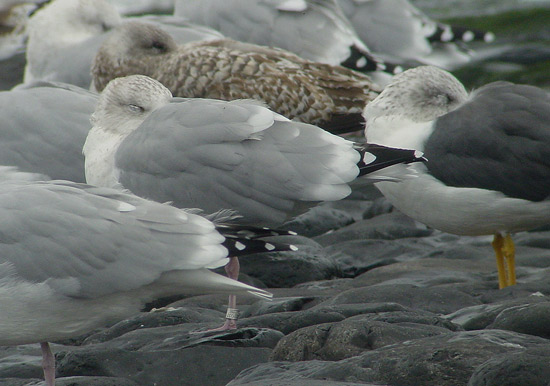 Herring
Gull - Zilvermeeuw (argentatus & argenteus)
Herring
Gull - Zilvermeeuw (argentatus & argenteus)
(last update: 18 januari 2005)
Home
Links
to Gull Sites
Gull Taxa
Gull Topography
Grey & Colour Charts
Locations in NW Europe
Summaries of Articles
About ORG
@
Herring Gull 4132037adult (argentatus), November 01 2002, Westkapelle, the Netherlands (51.33N-03.25E).
An adult with only relatively small white tips on the outer primaries for argentatus, ringed in Denmark: Copenhagen 132037. It was ringed as pullus on 24 June 1987, at Fyn Danmark (55.08N 10.05E). A typical argentatus, with the upper-parts dark grey (front left is a local argenteus, right is an intermedius), obvious darker than local Dutch argenteus Herring Gulls. The black sub-terminal band of primary P6 is complete and not split at the centre. Primary P7 has a broad black sub-terminal band. Primary P8 is slightly shorter than P7. The moult stage of the primaries is behind compared to local Dutch argenteus. The inner wing-coverts and upper tertials still have fresh fringes, in much better condition than found in some argenteus, which have these feathers replaced about 4 months ago and show worn fringes by November.
From June (often mid-May in France, Belgium and
the Netherlands) to October, a complete moult will bring birds in
so-called "adult winter" plumage. A new set of primaries will
grow during the summer months and by late November, the average argenteus in the Netherlands and northern
France has completely moulted all primaries. At the same time, the wing-covert moult is completed by the end
of the month. Argentatus from Scandinavia are behind in
primary moult.
In summer, the head is still largely white,
but by September, most adults develop extensive 'winter streaking', in
sub-adults strongly mottled
brown contrasting with the white breast as in an executioner's hood.
The scapular coverts are plain grey, lacking white crescents. The tertials
show obvious white tips. The iris is yellow. The bill is yellow with a red
gonydeal spot confined to the lower mandible. The orbital ring is
yellow-orange in most argenteus, slightly darker, orange-red or
coral red in argentatus.
